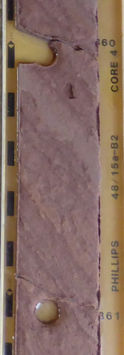WHY CUT CORE?
It's important to understand not only about core material, but also where it comes from and how it is collected. The following information gives more details about how wells are drilled and core is taken to gain knowledge about the rocks beneath the surface.
Core is collected kilometres below the Earth's surface and provides an undisturbed rock sample. This differs from normal well operations, where drilling is destructive and crushes the rock into small pieces called "cuttings".
Core is collected from depths of specific interest, which in the North Sea is usually reservoir sections where hydrocarbons are thought to be present. By understanding the sedimentology, stratigraphy and properties of the rocks, geologists can interpret how they formed and better understand how the hydrocarbon system works.
While most core is cut to understand specific zones of interest, it can also be used to prove a well has reached geological basement (hard crystalline rock) in a "Total Depth Core" or TD Core. More rarely, coring was used in the past to drill extremely hard rock that would otherwise cause a regular drill bit to wear down too quickly.
CUTTING CORE
When a well has been drilled to the desired depth to collect core, the drill bit is swapped for a core bit. It costs significant time to attach the core bit because all of the drilling equipment (drill string) needs to be taken out of the borehole and lowered back in. This is the reason core is expensive and only cut at stratigraphic depths of extreme interest.
But how does coring work? As part of a project with the GEO EXPRO magazine and website, we headed to Reservoir Group’s coring warehouse and workshop in Aberdeenshire where Steve Rait – coring manager Europe – explained us how an assembly looks like and how the process of getting the rocks out of the ground really works. After watching this video, you will have a much better handle on the various terms used for the coring process.
HALF CUT CORE
Core material is cut down the length of the core barrel and can either be a half, a third or a quarter of the original core diameter. Core is available in lengths of 3 ft/1 m or by the 10 ft/3 m box, but can be shorter if sections have been removed for analysis.
BISCUIT CUT CORE
Thin sections (2-3 cm thick) or "slabs" of core in lengths of 3 ft/1 m. They are produced by cutting down the length and through the middle of the core barrel. They are typically preserved in resin, although the type and quality of resin will vary depending on the age of the sample.
MISSING SECTIONS
Depending on the rock being drilled, not all core is recovered to surface. If it is very weak or unconsolidated, it can break up and cause missing sections. Other data sets, such as Logging While Drilling (LWD) and wireline logs, provide additional geophysical and geochemical information on the formation and rock properties.

BISCUIT CUT CORE PHOTOS
HALF CUT CORE PHOTOS























































